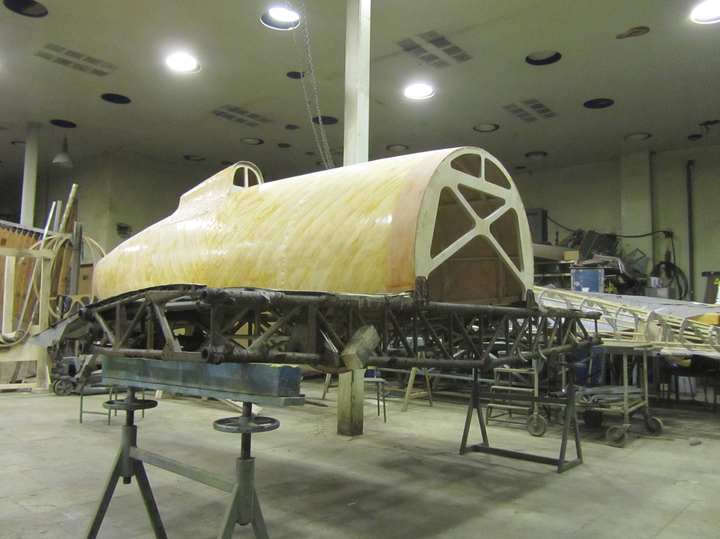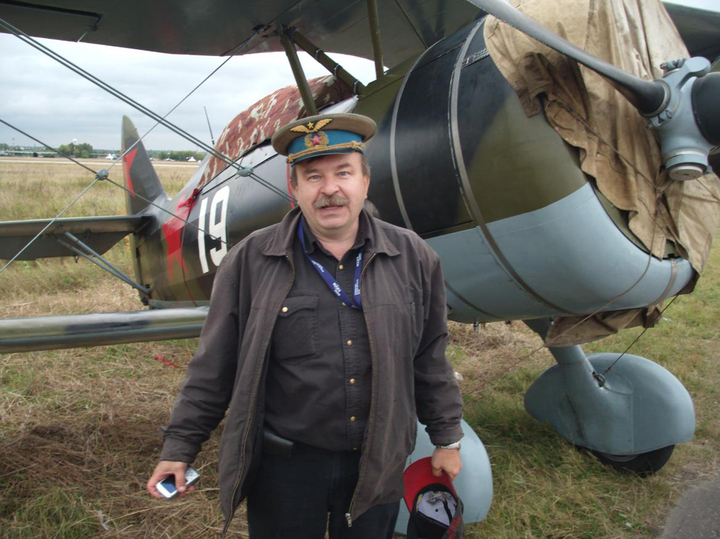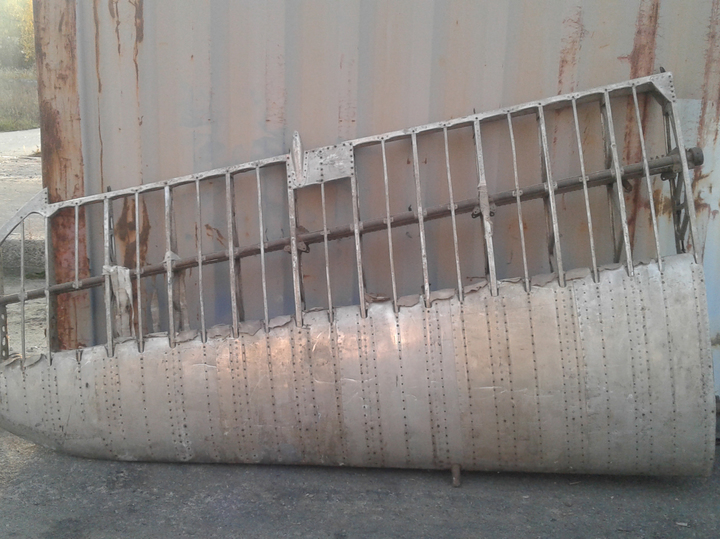A Russian restorer decided to take into the sky a unique I-16 fighter from the Great Patriotic War
[ad_1]
My interlocutor became an aircraft restorer in the mid-1990s. Since then, he has put in order the Yak-3 fighter, the Po-2 light bomber… For the last few years, Leiko has been busy restoring the legendary wartime fighter I-16 and dreams of one day taking it into the sky.
“The “Donkey,” as it was popularly called, was the most widely replicated fighter in the world in the late 1930s, the plane on which the Soviet aces of the Great Patriotic War began to fly,” says Leiko. — For 1933, when the first prototype was assembled, it was a colossal breakthrough in aircraft construction; at that time nothing like it existed. The I-16 accelerated to 400 km/h, while the average fighter of that time could barely reach 300–350 km/h.
General designer Nikolai Polikarpov considered that all the innovations that existed at that time should be applied to the design of the aircraft. As a result, the I-16 turned out to be extremely original, but it was not easy for the pilots to master it. Nevertheless, the “sixteenth” very quickly gained respect for itself, and it began to be mass-produced. By the early 1940s, the Red Army Air Force was equipped with thousands of such fighters. The I-16 flew until 1945; some examples survived in the Far East after the war. In the European part, where the battles of the Great Patriotic War unfolded, the last “donkeys” were crossed off from the lists of military equipment back in 1943.
Now seeing this single-engine monoplane in the air is as unlikely as finding an original Leonardo da Vinci in the storerooms of a provincial museum.
— Didn’t the originals of this fighter survive to this day?
— More than 10,000 of these combat vehicles were produced. Of such a huge number of I-16s, the aircraft that has survived to this day “in the original” is located in the Chkalov Museum (Chkalovsk, Nizhny Novgorod Region). Another surviving copy is attributed to the famous ace, twice Hero of the Soviet Union Boris Safonov, who allegedly flew it. This aircraft is located in the Naval Museum in St. Petersburg. The third surviving I-16 in the form of a training fighter was saved in Finland. As far as I know, there is a mockup in China that may contain the original I-16 components. In addition, one restored such fighter is kept in the aviation museum in Monin, and several more were built using “native” elements from the “donkey” in Novosibirsk on orders from foreign collectors. These planes have been brought to flying condition – they have been equipped with engines from the An-2 “maize machine”.
— Why did you decide to restore the I-16?
— Until 1990, I didn’t think about anything like that, I worked on ground tests of passenger and military transport aircraft. Then I realized that this topic was being closed, since in Russia at that time interest in civil aviation was being lost, and foreign Boeings and Airbuses were already on the way. And then I founded the first independent aviation magazine in Russia. Our editors began to regularly receive letters from readers interested in aviation: “we have something here that looks like the remains of a downed plane,” “we found fragments like this, help us determine what it is.” We started helping. In 1994, I went for the first time to look at such unidentified parts of the aircraft. It was I-16! Then it so happened that a representative of official authorities approached me and my colleagues with an unexpected proposal: to start making several models of airplanes from the Great Patriotic War for the exhibition of the museum on Poklonnaya Gora. We agreed. The second model that had to be made then was the “donkey”. We managed to figure out the design of this fighter, find the drawings, pull out the remains of the aircraft found in the Leningrad region, which I just mentioned; some fragments of it were used in the construction of the model. Now this I-16 is on display of full-scale samples on Poklonnaya.

– Is he not on the fly?
– No, this is just a model showing visitors what the I-16 looked like. There is only one example of the “donkey” in Russia, restored and brought to flying condition. But it has not taken off since the accident that happened in 2011; repairs to this veteran are ongoing. And pilots who flew restored I-16s abroad consistently crashed three fighters of this type, since it is very difficult to control when landing. As a result, they refused to fly the Soviet I-16, sold to America, considering it too dangerous.
— Let’s return to the story of how you decided to undertake a complete restoration of a fighter aircraft from the 1930s and early 1940s…
“My colleagues and I were very impressed that in Novosibirsk they managed to restore several I-16s by order of the famous New Zealand collector Tim Wallace. But the copies that were recreated for him by the Novosibirsk people had a peculiarity: they were equipped with engines from the An-2, which were heavier than those used in the original I-16. In addition, the An-2 propeller has four blades, while real “donkeys” flew with two-blade propellers. Therefore, it turned out that the Novosibirsk version of the aircraft was 200–220 kilograms heavier than its ancestor. This difference in mass was enough to cause three absolutely identical landing accidents. The fact is that the pilot flying the I-16 assembled in Novosibirsk, due to the fact that the weight of the fighter increased, but the wing area remained the same, had to maintain a higher speed. And as soon as he came in to land, he released the gas, the plane sank and hit the runway. At the same time, the landing gear broke, and then a “compass” followed, this is when the fighter on its belly spins along the airfield strip…
It became clear to me: the reason for such retro-aircraft accidents is a heavier engine than the original. Once we discussed this issue with Valery Bezruchenko, a man who devoted most of his life to the sky. He is an international master of sports and a five-time champion of Russia in parachuting, a champion in airplane sports…

Valery agreed with my conclusions and expressed the idea that it would be nice to restore the I-16 with its original engine and propeller. Well, or at least those whose weight characteristics coincide with the original. Then landing on such a retro plane will become much safer.
This conversation became the catalyst for everything that happened next. I offered Bezruchenko the option of building a “donkey,” realizing that I had a large supply of suitable components and individual elements of such a fighter. Then we got our hands on a completely new center section, wing and many genuine parts from the I-16.
Valery and I decided to use all this when restoring the “donkey”. The work has begun. We managed to find real engines from the I-16. They are from fighters shot down or forced to land during the war, which were discovered by search engines many years later. Of course, the state of this technology is far from ideal. We disassembled several motors, made sure that some of the parts were damaged and destroyed, but some could be used.
The only problem is that things are moving slowly. The work is very complex, and there are almost no high-level specialists in old piston engines. But success will be ours!
– How big is this thing – an engine from an I-16 fighter?
— Motor with a power of about 1000 hp. Its diameter is 1.2 meters, length is almost 1.3 meters. It weighs about 600 kilograms. With a propeller – even more. Moreover, the assembled weight of the I-16 itself is about two tons.
— How many years does the revival of I-16 last?
— We started this project in 2017.
— Judging by what I heard, what you do looks like the painstaking work of restorers of ancient works of art…
– Yes, close! Although painting restorers have their own difficulties: they need a steady hand, they need a selection of paints… But our main problems are related to limited technical capabilities. You have to do everything manually. It is almost impossible to order anything from a factory.
– What is the end result? What is your goal?
— The goal is quite specific: for the I-16 we revived to fly. I really want to preserve the tangible memory of Soviet aviation during World War II. Because, no matter how large the Soviet Air Force fleet was then, by our time it has completely disappeared; almost nothing remains of those tens of thousands of winged machines.
This is a paradox! For example, more than 100 German Messerschmitts survived in the world. Somewhere they fly, somewhere they stand as museum, collection exhibits. And our surviving aircraft, for example Il-2, can be counted on one hand. Although both of them were released approximately equally, about 36 thousand copies. Such a “flying tank” stands as a monument in Plovdiv, Bulgaria, another in Poland, and a third in one of the republics of the former Yugoslavia. We have an IL-2 in the museum in Monino; it was restored for filming in the 1970s. In Samara, Ilyushin’s attack aircraft is placed on a pedestal. Once upon a time, this Il was shot down, then found by search engines, at the factory where they were produced during the war, and restored to museum condition. But inside, not everything is close to the original…

This situation with the preservation of domestic historical aircraft, in my opinion, is a shame. You know, like in the wonderful film – “It’s a shame for the state.” There is more left of German aviation of that time, and much more of English aviation. The Americans still have thousands of vintage aircraft. And we clearly overdid it in terms of destroying the “machines from the past.” For example, in 1949, orders were given: to destroy exhibitions of aircraft, including captured aircraft…
— Now you’ve finally restored a retro plane, but who will take it into the air? Who are these people who will dare to be the first to take the helm of the restored winged veterans to test them in flight?
— These are professional test pilots, since, according to aviation safety rules, other people do not have the right to fly such equipment.
— That is, the restorers say: “We have assembled the plane, everything is ready, we are confident in it. Now it’s your turn to put it to the test!”
– Approximately so. Of course, there is a technical commission and checks required by regulations, which show how ready the aircraft is. If everything is in order, the test pilot, having become accustomed to the controls, lifts the car into the air. At the same time, he sometimes faces very unusual manipulations. If we talk specifically about the I-16, this fighter has an extremely complex, for example, process of retracting the landing gear. Everything was done by hand: the pilot turned a knob in the cockpit, activating a system of cables that pulled the landing gear into special niches under the wings. But the reverse procedure – releasing the landing gear – on this fighter occurred due to gravity: the pilot released the lock of the landing gear cable, and the landing gear fell down under the influence of its own weight. Primitive? And what do you want?! After all, it was 1933 when this structure was created; it will soon be 100 years old! Valery Chkalov was the first to test the I-16, and, by the way, in the old film dedicated to the famous Soviet pilot, there is an episode where Valery Pavlovich tries to shake out one of the landing gear, which was jammed while performing aerobatics.
[ad_2]
Source link








